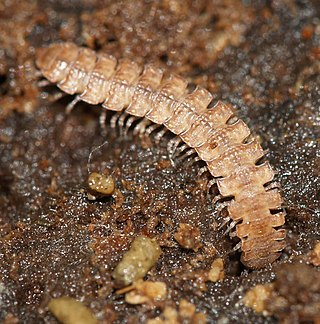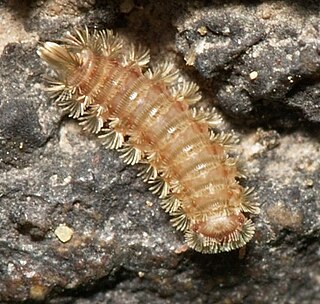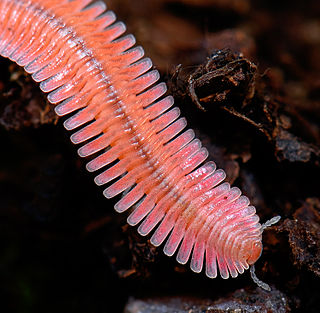Callipodida

Suborder Callipodidea
Suborder Schizopetalidea
Suborder Sinocallipodidea
Millipedes, myriapods of the class Diplopoda, contain approximately 12,000 described species organized into 16 extant orders and approximately 140 families. This list is based on Shear, 2011, [1] sorted alphabetically by order and taxonomically within order.
Note: The names of millipede orders end in "-ida"; suborders end in "-idea". Superfamilies end in "-oidea", while families end in "-idae". [2]

Suborder Callipodidea
Suborder Schizopetalidea
Suborder Sinocallipodidea
Superfamily Chordeumatoidea
Superfamily Anthroleucosomatoidea
Superfamily Brannerioidea
Superfamily Cleidogonoidea
Superfamily Craspedosomatoidea

Superfamily Haaseoidea
Superfamily Neoatractosomatoidea
Superfamily Verhoeffioidea
Superfamily Conotyloidea
Superfamily Diplomaragnoidea
Superfamily Heterochordeumatoidea

Superfamily Pygmaeosomatoidea
Superfamily Caseyoidea
Superfamily Striarioidea

Superfamily Blaniuloidea
Superfamily Juloidea
Superfamily Nemasomatoidea

Superfamily Paeromopodoidea
Superfamily Parajuloidea

Superfamily Chelodesmoidea
Superfamily Platyrhacoidea

Superfamily Rhachodesmoidea
Superfamily Sphaeriodesmoidea
Superfamily Xystodesmoidea

Superfamily Oniscodesmoidea
Superfamily Pyrgodesmoidea
Superfamily Haplodesmoidea
Superfamily Opisotretoidea
Superfamily Trichopolydesmoidea

Superfamily Polyxenoidea
Superfamily Synxenoidea





Superfamily Odontopygoidea
Superfamily Spirostreptoidea

Extinct millipede groups

Millipedes are a group of arthropods that are characterised by having two pairs of jointed legs on most body segments; they are known scientifically as the class Diplopoda, the name derived from this feature. Each double-legged segment is a result of two single segments fused together. Most millipedes have very elongated cylindrical or flattened bodies with more than 20 segments, while pill millipedes are shorter and can roll into a tight ball. Although the name "millipede" derives from the Latin for "thousand feet", no species was known to have 1,000 or more until the discovery of Eumillipes persephone, which can have over 1,300 legs. There are approximately 12,000 named species classified into 16 orders and around 140 families, making Diplopoda the largest class of myriapods, an arthropod group which also includes centipedes and other multi-legged creatures.

Chilognatha is a subclass of the class Diplopoda, which includes the vast majority of extant millipedes, about 12,000 species.

Pill millipedes are any members of two living orders of millipedes, often grouped together into a single superorder, Oniscomorpha. The name Oniscomorpha refers to the millipedes' resemblance to certain woodlice (Oniscidea), also called pillbugs or "roly-polies". However, millipedes and woodlice are not closely related ; rather, this is a case of convergent evolution.

Spirobolida is an order of "round-backed" millipedes containing approximately 500 species in 12 families. Its members are distinguished by the presence of a "pronounced suture that runs "vertically down the front of the head". Most of the species live in the tropics, and many are brightly coloured. Mature males have two pairs of modified legs, the gonopods, consisting of the 8th and 9th leg pair: the posterior gonopods are used in sperm-transfer while the anterior gonopods are fused into a single plate-like structure.

Glomerida is an order of pill-millipedes found primarily in the Northern Hemisphere. They superficially resemble pill-bugs or woodlice, and can enroll into a protective ball. They have twelve body segments, 17 to 19 pairs of legs, and males have enlarged rear legs involved in mating. The order includes about 30 genera and at least 280 species, including Glomeris marginata, the common European pill-millipede. The order contains members in Europe, South-east Asia and the Americas from California to Guatemala. Although historically considered closely related with the similar sphaerotheriidans that also enroll, some DNA evidence suggest they may be more closely related to glomeridesmidans, a poorly known order that does not enroll.

Spirostreptida is an order of long, cylindrical millipedes. There are approximately 1000 described species, making Spirostreptida the third largest order of millipedes after Polydesmida and Chordeumatida.

Polydesmida is the largest order of millipedes, containing approximately 3,500 species, including all the millipedes reported to produce hydrogen cyanide (HCN).

Julida is an order of millipedes. Members are mostly small and cylindrical, typically ranging from 10–120 millimetres (0.39–4.72 in) in length. Eyes may be present or absent, and in mature males of many species, the first pair of legs is modified into hook-like structures. Additionally, both pairs of legs on the 7th body segment of males are modified into gonopods.

Polyxenida is an order of millipedes readily distinguished by a unique body plan consisting of a soft, non-calcified body ornamented with tufts of bristles – traits that have inspired the common names "bristly millipedes" or "pincushion millipedes". There are at least 86 species in four families worldwide, and are the only living members of the subclass Penicillata.

Polyxenidae is a family of millipedes in the order Polyxenida containing approximately 47 species in 19 genera. Adults in all species in this family have 13 pairs of legs.

Glomeridesmida is an order of millipedes in the infraclass Pentazonia containing 2 families and at least 31 species. Glomeridesmida is the only living order of the superorder Limacomorpha. Glomeridesmidans are small and somewhat flattened, and unlike other orders of Pentazonia, are unable to roll into a ball. Ocelli (eyes) are absent.

Platydesmida is an order of millipedes containing two families and over 60 species. Some species practice paternal care, in which males guard the eggs.

Callipodida is an order of millipedes containing around 130 species, many characterized by crests or ridges.

Dalodesmidae is a family of millipedes in the order Polydesmida, containing at least 250 species found in the Southern Hemisphere.

Chordeumatida is a large order of millipedes containing some 1200 species with a nearly worldwide distribution. Also known as "sausage millipedes," they possess around 30 body segments behind the head as adults and reach about 25 mm (0.98 in) in length.

Siphoniulus is a poorly known genus of millipede containing only two living species: S. alba from Indonesia, and S. neotropicus from Mexico and Guatemala. An additional two fossil species are known from Cretaceous amber. Siphoniulus species are the only members of the family Siphoniulidae and order Siphoniulida, making Siphoniulida the smallest millipede order. Few specimens are known, and their classification is contentious, although most recent studies place them as basal members of the Helminthomorpha.

Stemmiulida is an order of millipedes consisting of approximately 130 species, reaching up to 50 mm in length. It contains a single family, Stemmiulidae.

Casimir Albrecht Willem Jeekel (1922–2010) was a Dutch myriapodologist and entomologist known for his major contributions to the taxonomy of millipedes. His 1971 monograph Nomenclator Generum et Familiarum Diplopodorum is credited as launching the "modern era" of millipede taxonomy, and has been considered the "most important single work ever published on the Diplopoda". He served as director of the Zoological Museum Amsterdam, and authored over 150 works on the taxonomy of millipedes and other myriapods.

Pyrgodesmidae is a family of flat-backed millipedes in the order Polydesmida. The family contains over 200 species distributed in tropics around the world. Some species are found only in ant colonies, and are considered obligate myrmecophiles.
Glomeridesmidae, is a millipede family of the order Glomeridesmida. Adult females in this family have 36 pairs of legs and 21 segments, counting 20 tergites plus the anal shield. Male specimens in this family are rare and known for only a small number of species. Descriptions of mature males in at least three species report 35 pairs of legs, including a pair of telopods, and 20 segments, one fewer than the 21 segments found in adult females. The description of an adult male of another species, however, reports 37 pairs of legs, including a pair of telopods, and the same 21 segments normally found in adult females. The family includes 27 species belonging to one genus.